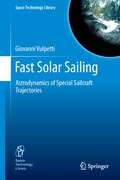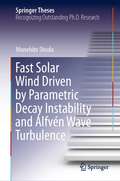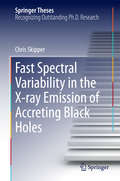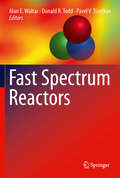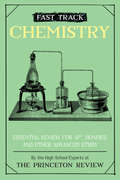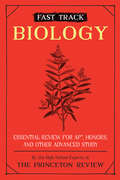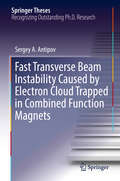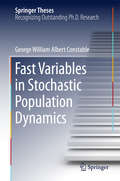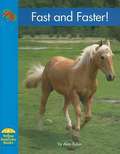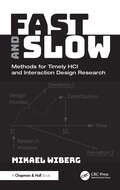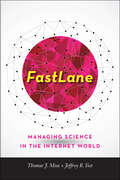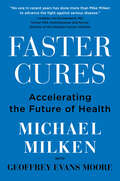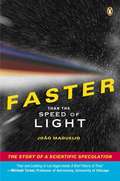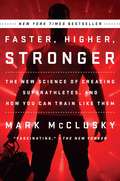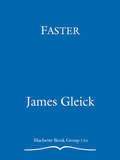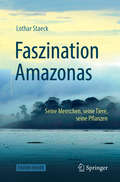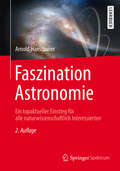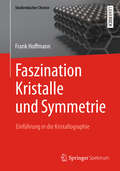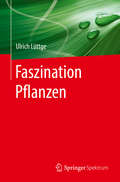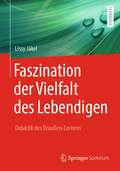- Table View
- List View
Fast Solar Sailing
by Giovanni VulpettiThe range of solar sailing is very vast; it is a fully in-space means of propulsion that should allow us to accomplish various mission classes that are literally impossible using rocket propulsion, no matter if nuclear or electric. Fast and very fast solar sailings are special classes of sailcraft missions, initially developed only in the first half of the 1990s and still evolving, especially after the latest advances in nanotechnology. This book describes how to plan, compute and optimize the trajectories of sailcraft with speeds considerably higher than 100 km/s; such sailcraft would be able to explore the outer heliosphere, the near interstellar medium and the solar gravitational lens (550-800 astronomical units) in times significantly shorter than the span of an average career (~ 35 years), just to cite a few examples. The scientific interest in this type of exploration is huge.
Fast Solar Wind Driven by Parametric Decay Instability and Alfvén Wave Turbulence (Springer Theses)
by Munehito ShodaThis book discusses key theoretical aspects concerning the formation of the solar wind: the most essential building block in the heliosphere, in which planets orbit. To understand the influence of solar activity on planetary magnetospheres and atmospheres, we need to first understand the origin of the solar wind, which is still under debate. This book presents the outcomes of state-of-the-art numerical simulations of solar wind acceleration, including the first three-dimensional simulation of the turbulence-driven solar wind model. One of the book’s goals is to include compressional effects in the dynamics of solar wind turbulence; accordingly, it discusses parametric decay instability in detail. Several key aspects that are relevant to the Parker Solar Probe observations are also discussed. Given its scope, the book plays a key role in bridging the gap between the theory of magnetohydrodynamic turbulence and current/future in-situ observations of the solar wind. This book is based on the Ph.D. thesis by the author, which won the 2019 International Astronomical Union Division E Ph.D. prize.
Fast Spectral Variability in the X-ray Emission of Accreting Black Holes
by Chris SkipperThis thesis brings together the various techniques of X-ray spectral analysis in order to examine the properties of black holes that vary in mass by several orders of magnitude. In all these systems it is widely accepted that the X-ray emission is produced by Compton up-scattering of lower energy seed photons in a hot corona or accretion flow, and here these processes are examined through a study of the X-ray spectral variability of each source. A new technique is introduced, in which models are fitted to over 2 million X-ray spectra on time-scales as short as 16 ms, and subsequently it is shown that the nature of the correlation between intensity and spectral index is strongly dependent upon the spectral state of the black hole. Finally, the results of an extensive survey of nearby galactic nuclei using the Chandra X-ray telescope are presented in the form of images and spectra, and these results are used along with data from the literature to search for Compton-thick nuclei.
Fast Spectrum Reactors
by Alan E. Waltar Donald R. Todd Pavel V. TsvetkovThis book is a complete update of the classic 1981 FAST BREEDER REACTORS textbook authored by Alan E. Waltar and Albert B. Reynolds, which , along with the Russian translation, served as a major reference book for fast reactors systems. Major updates include transmutation physics (a key technology to substantially ameliorate issues associated with the storage of high-level nuclear waste ), advances in fuels and materials technology (including metal fuels and cladding materials capable of high-temperature and high burnup), and new approaches to reactor safety (including passive safety technology), New chapters on gas-cooled and lead-cooled fast spectrum reactors are also included.Key international experts contributing to the text include Chaim Braun, (Stanford University) Ronald Omberg, (Pacific Northwest National Laboratory, Massimo Salvatores (CEA, France), Baldev Raj, (Indira Gandhi Center for Atomic Research, India) , John Sackett (Argonne National Laboratory), Kevan Weaver, (TerraPower Corporation) ,James Seinicki(Argonne National Laboratory). Russell Stachowski (General Electric), Toshikazu Takeda (University of Fukui, Japan), and Yoshitaka Chikazawa (Japan Atomic Energy Agency).
Fast Track to a 5: Preparing for the AP Environmental Exam
by David Hong Karen LionbergerA textbook to prepare you for the Ap* Environmental Science Examination.
Fast Track: Essential Review for AP, Honors, and Other Advanced Study (High School Subject Review)
by The Princeton ReviewGET UP TO SPEED WITH FAST TRACK: CHEMISTRY! Covering the most important material taught in high school chem class, this essential review book breaks need-to-know content into accessible, easily understood lessons.Inside this book, you'll find:• Clear, concise summaries of the most important concepts, terms, and functions in chemistry• Diagrams, charts, and graphs for quick visual reference• Easy-to-follow content organization and illustrationsWith its friendly, straightforward approach and a clean, modern design crafted to appeal to visual learners, this guidebook is perfect for catching up in class or getting ahead on exam review.Topics covered in Fast Track: Chemistry include:• Atomic structure• Covalent bonding• Intermolecular forces• Stoichiometry• Precipitation reactions• Gas laws• Thermochemistry• Equilibrium and the solubility product constant• Redox reactions• Electrochemistry• Acids and bases• Kinetics... and more!
Fast Track: Essential Review for AP, Honors, and Other Advanced Study (High School Subject Review)
by The Princeton ReviewGET UP TO SPEED WITH FAST TRACK: BIOLOGY! Covering the most important material taught in high school biology class, this essential review book breaks need-to-know content into accessible, easily understood lessons. Inside this book, you'll find:• Clear, concise summaries of the most important concepts, terms, and functions in biology• Diagrams, charts, and graphs for quick visual reference• Easy-to-follow content organization and illustrationsWith its friendly, straightforward approach and a clean, modern design crafted to appeal to visual learners, this guidebook is perfect for catching up in class or getting ahead on exam review. Topics covered in Fast Track: Biology include:• The chemistry of life• Cells and cellular energetics• Molecular genetics• Heredity and genetics• Evolutionary biology and natural selection• Cell reproduction• Animal structure and function• Behavior and ecology• Biostatistics• Plants... and more!
Fast Transverse Beam Instability Caused by Electron Cloud Trapped in Combined Function Magnets (Springer Theses)
by Sergey A. AntipovThis thesis presents profound insights into the origins and dynamics of beam instabilities using both experimental observations and numerical simulations. When the Recycler Ring, a high-intensity proton beam accelerator at Fermi National Accelerator Laboratory, was commissioned, it became evident that the Recycler beam experiences a very fast instability of unknown nature. This instability was so fast that the existing dampers were ineffective at suppressing it. The nature of this phenomenon, alongside several other poorly understood features of the beam, became one of the biggest puzzles in the accelerator community. The author investigated a hypothesis that the instability arises from an interaction with a dense cloud of electrons accompanying the proton beam. He studied the phenomena experimentally by comparing the dynamics of stable and unstable beams, by numerically simulating the build-up of the electron cloud and its interaction with the beam, and by constructing an analytical model of an electron cloud-driven instability with the electrons trapped in combined-function dipole magnets. He has devised a method to stabilize the beam by a clearing bunch, which conclusively revealed that the instability is caused by the electron cloud, trapped in a strong magnetic field. Finally, he conducted measurements of the microwave propagation through a single dipole magnet. These measurements have confirmed the presence of the electron cloud in combined-function magnets.
Fast Variables in Stochastic Population Dynamics
by George William Albert ConstableIn this thesis two variants of the fast variable elimination method are developed. They are intuitive, simple to implement and give results which are in very good agreement with those found from numerical simulations. The relative simplicity of the techniques makes them ideal for applying to problems featuring demographic stochasticity, for experts and non-experts alike. Within the context of mathematical modelling, fast variable elimination is one of the central tools with which one can simplify a multivariate problem. When used in the context of of deterministic systems, the theory is quite standard, but when stochastic effects are present, it becomes less straightforward to apply. While the introductory and background chapters form an excellent primer to the theory of stochastic population dynamics, the techniques developed can be applied to systems exhibiting a separation of timescales in a variety of fields including population genetics, ecology and epidemiology.
Fast and Faster!
by Alan RubinDescribes how animals and vehicles move in different ways and at different speeds.
Fast and Slow: Methods for Timely HCI and Interaction Design Research
by Mikael WibergFast and Slow: Methods for Timely HCI and Interaction Design Research explores the dynamic interplay between rapid and reflective, or long-term vs. short-term research in human–computer interaction (HCI) and interaction design research. In an era where fast approaches to technical research are foregrounded, this book provides a critical examination of the temporalities at play in various research approaches – from long-term empirical studies to rapid prototyping. Ultimately, it asks the fundamental question of how to make timely research contributions and how to plan research projects to be timely in terms of impact.Drawing inspiration from fast and slow thinking, design thinking, and our ever-changing world, this book contrasts "fast" approaches – such as "quick-and-dirty" ethnography, prototyping, and AI-driven automation – with "slow" methodologies that emphasize ethnographic studies, longitudinal research, and participatory design. By working across the fast and slow approaches to research, the book helps researchers and practitioners navigate the trade-offs between efficiency and depth, rapid results, and reflection. Ultimately, the focus of the book is on timely research contributions.With a focus on research approaches, this book presents cases, methodological insights, and theoretical discussions that foreground the temporalities at play in HCI and interaction design research. It questions whether the rush to develop, iterate, and deploy can sometimes obscure critical insights about human behavior, emerging phenomena, ethical considerations, and long-term impact.Whether you are an HCI researcher, UX practitioner, or technology strategist, Fast and Slow: Methods for Timely HCI and Interaction Design Research offers a fresh perspective on how to plan and carry out HCI and interaction design research – over time.
FastLane: Managing Science in the Internet World (Johns Hopkins Studies in the History of Technology)
by Thomas J. Misa Jeffrey R. YostThe unique history and development of FastLane, the central nervous system of the National Science Foundation.Since 2000, the National Science Foundation has depended upon its pioneering FastLane e-government system to manage grant applications, peer reviews, and reporting. In this behind-the-scenes account Thomas J. Misa and Jeffrey R. Yost examine how powerful forces of science and computing came together to create this influential grant-management system, assessing its impact on cutting-edge scientific research.Why did the NSF create FastLane, and how did it anticipate the development of web-based e-commerce? What technical challenges did the glitch-prone early system present? Did the switch to electronic grant proposals disadvantage universities with fewer resources? And how did the scientific community help shape FastLane? Foregrounding the experience of computer users, the book draws on hundreds of interviews with scientific researchers, sponsored project administrators, NSF staff, and software designers, developers, and managers.
Faster Cures: Accelerating the Future of Health
by Michael MilkenPartly a memoir and partly a recent history of medicine, the definitive account of Michael Milken’s lifetime work to accelerate medicine's evolution from a dark past to a bright future.What if cleaning early-stage cancers from your body could become as routine as going to the dentist to clean your teeth, or if a single vaccine could protect you against multiple viruses, or if gene editing could eliminate many birth defects and slow the aging process? Mike Milken believes these, and many other advances, are within reach.Beginning with a description of the 1950s civilization and culture that helped shape Milken's early views, Faster Cures traces the life-extending acceleration of progress in medical research, public health, and clinical treatments over the seven decades since Milken’s childhood—and shows how he helped transform the process of developing disease cures. Among many examples, he recognized the promise of immunology more than twenty-five years ago and provided crucial support for the emergence of immunotherapy as a powerful life-saving treatment.Detailing his unique personal journey from a curious boy with an insatiable thirst for knowledge to his storied careers in finance and health, this book focuses on the events that made Milken what Fortune magazine called “The Man Who Changed Medicine.” The combined influences of social upheaval in the 1960s and family medical crises in the 1970s propelled him to dual quests on Wall Street and in medical research.Known worldwide as a legendary financier, philanthropist, medical research innovator, and public health advocate, Milken tells fascinating anecdotes and explains his inspiring crusade to accelerate cures and treatments so that more people around the world can live longer, healthier, and more meaningful lives.
Faster Than Light
by George Zebrowski Jack DannShort stories and scientific articles about how we might do interstellar travel.
Faster Than the Speed of Light: The Story of a Scientific Speculation
by Joao MagueijoCould Einstein be wrong and Magueijo right? Equally pressing for Magueijo, a lecturer in theoretical physics at London's Imperial College, is whether the physics editor at the preeminent science journal Nature is in fact "a first class moron" for rejecting his last paper. And did that cosmologist from Princeton steal his idea? What about all those hours wasted writing requests for funding from those "parasites," those "ex-scientists well past their prime" who dispense the monies that make contemporary science possible? Welcome to the world of career science, disclosed here in all its flawed brilliance. Magueijo's heretical idea-- that the speed of light is not constant; light traveled faster in the early universe-- challenges the most fundamental tenet of modern physics. Deceptively simple, the theory came to the author during a bad hangover one damp morning in Cambridge, England (many of the author's breakthroughs seem to arrive at unexpected moments, like while he's urinating outside a Goan bar). If true, Magueijo's Variant Speed of Light theory, or VSL, rectifies apparent inconsistencies in the Big Bang theory. Magueijo cunningly frames his journey with the stories of other famous, courageous heretics, notably Einstein himself, and one suspects an apologetics at work here. Magueijo, a 35-year-old native of Portugal, is opinionated and can seem immature and almost bratty in his diatribes against the banalities of academia or the hypocrisy and backbiting of peer review. But his science is lucidly rendered, and even his penchant for sturm und drang sheds light on the tensions felt by scientists incubating new ideas. This book shows how science is done-and so easily can be undone. Copyright 2002 Reed Business Information, Inc.
Faster, Higher, Stronger
by Mark MccluskyThe world of high-performance athletics is changing forever. Not so long ago, you could compete at the top level with hard work and a good coach, but today, it's impossible to separate the achievements of athletes from the scientists who support them. In Faster, Higher, Stronger, veteran journalist Mark McClusky brings readers behind the scenes with a new generation of athletes, coaches, and scientists whose accomplishments are changing our understanding of human physical achievement and completely redefining the limits of the human body. At the exciting new frontier of sports, science, and technology, the book explores: * The role that genes and training play * How to find hidden champions and fasttrack greatness * The truth about the 10,000 hours rule * New research on breaking through fatigue * Revolutions in data and nutrition * And how we can apply the lessons about focus, dedication, and sheer ingenuity in our own lives. Brimming with cutting-edge science and gripping anecdotes, Faster, Higher, Stronger is a fascinating, exhilarating look at how far we can push the boundaries of our bodies and minds.
Faster, Higher, Stronger
by Mark MccluskyA New York Times bestseller"A smart and important book." --Gretchen Reynolds, author of The First 20 Minutes Publications as varied as Wired, Men's Fitness, and The New Yorker are abuzz over the New York Times bestseller Faster, Higher, Stronger. In it, veteran journalist Mark McClusky explains how today's top athletes are turning to advanced technology and savvy science to improve their performance. Sports buffs and readers of David Epstein and Gretchen Reynolds will want to join McClusky as he goes behind the scenes everywhere from the Olympics to the NBA Finals, from the World Series to the Tour de France, and from high-tech labs to neighborhood gyms to show how athletes at every level can incorporate cutting-edge science into their own workouts.r, Stronger is a fascinating, exhilarating look at how far we can push the boundaries of our bodies and minds.
Faster: The Acceleration of Just About Everything
by James GleickFrom the bestselling, National Book Award-nominated author of Genius and Chaos, a bracing new work about the accelerating pace of change in today's world. Most of us suffer some degree of "hurry sickness," a malady that has launched us into the "epoch of the nanosecond," a need-everything-yesterday sphere dominated by cell phones, computers, faxes, and remote controls. Yet for all the hours, minutes, and even seconds being saved, we're still filling our days to the point that we have no time for such basic human activities as eating, sex, and relating to our families. Written with fresh insight and thorough research, Faster is a wise and witty look at a harried world not likely to slow down anytime soon.
Faszination Amazonas: Seine Menschen, seine Tiere, seine Pflanzen
by Lothar StaeckIn diesem Band wird der Amazonas und sein angrenzender Regenwald in allen wichtigen Facetten dargestellt: Zum einen ist es das riesige Flusssystem selbst mit seinem Geflecht aus Weiß-, Schwarz- und Klarwasserflüssen. Aus den unterschiedlichen Wasserqualitäten resultieren enorme Auswirkungen auf Menschen, Tiere und Pflanzen. Zum anderen werden die Menschen beschrieben, die an diesem "Rio Mar", dem Meeres-Fluss, leben. Es sind die Caboclos, die Nachfahren der europäischen Einwanderer und der Urbevölkerung, und es sind die unterschiedlichen indigenen Völker, die sich meist an den Flussufern niedergelassen haben, da die Flüsse hier die Straßen ersetzen und überhaupt erst einen Kontakt zu anderen Menschen ermöglichen. Diese Volksgruppen sind zwar seit Generationen mit der westlichen Zivilisation in Kontakt, doch sie haben überraschenderweise auch heute noch eine Reihe bemerkenswerter Traditionen bewahrt, die hier beschrieben werden. Der Schatz der Amazonasregion sind seine Pflanzen und Tiere. Deshalb werden ausführlich die faszinierendsten Blütenpflanzen, darunter zahlreiche Heilpflanzen, Bäume, Epiphyten und Lianen unterschiedlicher Lebensräume beschrieben und mit hervorragenden Fotos illustriert. Schließlich sind es die Tiere, vor allem im und am Fluss, aber auch im angrenzenden Regenwald, die uns Europäer seit Alexander von Humboldt schon immer fasziniert haben. Hier wird nicht nur die Lebensweise der legendären Rosa-Delfine, Piranhas und Vogelspinnen erläutert, sondern auch auf eindrucksvolle Amphibien, Reptilien und Säugetiere des Urwaldes eingegangen.
Faszination Astronomie
by Arnold Hanslmeier"Astronomie ist eine Wissenschaft die an die Grenzen geht. Man hat es mit unvorstellbar riesigen Raum- und Zeitdimensionen zu tun, unvorstellbaren heisen und auch kalten Objekten, und selbst in unserem mittlerweile auch durch Satellitenmissionen gut erforschtem Sonnensystem gibt es laufend neue Entdeckungen." (Aus dem Vorwort) In diesem Buch, das aus einer an der Universität Graz gehaltenen Vorlesung für Studierende aller Fakultäten entstanden ist, vermittelt Prof. Arnold Hanslmeier astronomische Kenntnisse, ohne dabei zuviel auf Physik und Mathematik einzugehen. Etwas tiefergehende Formeln und Textstellen sind vom Rest des Textes getrennt und können, ohne den Zusammenhang zu verlieren, übersprungen werden. Das Buch beginnt mit der Beschreibung des Ursprungs des Universums und reicht bis hin zu dunkler Materie, schwarzen Löchern und der Entstehung des Sonnensystems. Mit Hilfe vieler farbiger Bilder erläutert der Autor die Zusammenhänge anschaulich und allgemein verständlich. Am Ende des Buches geht es schließlich um die spannende Frage: Sind wir alleine im Universum? Das Buch wendet sich nicht nur an Studierende sondern auch an interessierte Laien sowie an alle die sich mit modernen Erkenntnissen der Naturwissenschaft beschäftigen. "Physik, insbesondere Astrophysik kann extrem spannend sein, ich hoffe, meine Leserinnen und Leser gewinnen durch die Lektüre dieses Buches diesen Eindruck!" A. Hanslmeier
Faszination Astronomie: Ein topaktueller Einstieg für alle naturwissenschaftlich Interessierten
by Arnold HanslmeierIn diesem Werk vermittelt Prof. Arnold Hanslmeier moderne und faszinierende astronomische Kenntnisse. Das Buch beginnt mit der Beschreibung des Ursprungs des Universums und reicht bis hin zu dunkler Materie, schwarzen Löchern und der Entstehung des Sonnensystems. Abgerundet wird es am Ende schließlich durch die spannende Frage: Sind wir allein im Universum?In dem Buch, das aus einer an der Universität Graz gehaltenen Vorlesung für Studierende aller Fakultäten entstanden ist, erläutert der Autor mit Hilfe vieler farbiger Bilder die Zusammenhänge anschaulich und allgemein verständlich, ohne dabei zu viel Grundwissen an Mathematik und Physik zu verlangen. Etwas tiefergehende Formeln und Textstellen sind vom Rest des Textes getrennt und können, ohne den Zusammenhang zu verlieren, übersprungen werden.In der vorliegenden dritten Auflage wurden neue Erkenntnisse wie z.B. die spektakuläre direkte Entdeckung der Gravitationswellen, faszinierende Aufnahmen und Daten von Pluto sowie die erste Landung auf einem Kometen berücksichtigt. Zum besseren Verständnis wurden zahlreiche neue Aufnahmen und Illustrationen hinzugefügt. Auch die neuesten Daten auf dem Bereich der Exoplanetenforschung wurden eingearbeitet.Das Buch wendet sich nicht nur an Studierende, sondern auch an interessierte Laien sowie an alle, die sich mit modernen Erkenntnissen der Naturwissenschaft beschäftigen. "Physik, insbesondere Astrophysik, kann extrem spannend sein, ich hoffe, meine Leserinnen und Leser gewinnen durch die Lektüre dieses Buches genau diesen Eindruck!" A. Hanslmeier
Faszination Kristalle und Symmetrie: Einführung in die Kristallographie (Studienbücher Chemie)
by Frank HoffmannDieses Buch lädt Sie zu einer systematischen Rundreise durch die faszinierende Welt der Kristalle und ihrer Symmetrien ein. Sie werden mit der Symmetrie äußerer Kristallformen (Morphologie) ebenso vertraut gemacht wie mit ihrer inneren Struktur und lernen sämtliche Symmetrieelemente kennen, die zu Klassifizierung und Beschreibung von Kristallstrukturen benötigt werden. Das Buch erklärt die Zusammenhänge auf eine sehr anschauliche, nicht-mathematische Art und Weise und besticht durch klare, hochwertige Abbildungen. Online-Materialien begleiten das Buch; so unterstützen 3D-Modelle, die Sie am Bildschirm erkunden können, das räumliche Verständnis des Aufbaus von Kristallen.Nach der Lektüre des Werkes werden Sie nicht nur wissen, was eine Raumgruppe ist und wie die Internationalen Tabellen für Kristallographie zu lesen sind, sondern auch kristallographische Spezifikationen in Fachpublikationen deuten können. Und wenn Sie wirklich etwas nicht verstehen, haben Sie Gelegenheit, auf der Website zum Buch dem Autor Fragen zu stellen.
Faszination Meeresforschung: Ein ökologisches Lesebuch
by Kai Bischof Gotthilf Hempel Wilhelm HagenIn diesem Buch berichten 95 Wissenschaftlerinnen und Wissenschaftler über ihre Forschung im Ozean und an den Küsten. Sie führen den Leser von den eisbedeckten Polarmeeren über die Nord- und Ostsee bis zu den Seegraswiesen, tropischen Mangroven und Korallenriffen. Die Beiträge veranschaulichen die Vielfalt der Lebensgemeinschaften zwischen Strand und Tiefsee. Das Größenspektrum der Organismen reicht von Walen und Fischen über Planktonkrebse und Muscheln bis zu Kieselalgen und Bakterien. Die globalen – vom Leben im Meer bestimmten – Stoffkreisläufe werden ebenso behandelt wie die molekularbiologischen Anpassungen der Mikroorganismen, und hier sind auch die größten methodischen Fortschritte zu verzeichnen.Zu den spannenden Themen der angewandten Meeresforschung gehören die Überfischung und die nachhaltige Nutzung der Meere, die Gefährdung durch Schad- und Nährstoffeinträge, das Einschleppen fremder Organismen und die Zerstörung von Lebensräumen. Vielfältig und bereits deutlich nachweisbar sind die Einflüsse des globalen Klimawandels auf das Leben im Meer. Forschungsschiffe, Unterwasser-Roboter, Gensonden und Datenbanken, aber auch mathematische Modelle und naturnahe Experimente sind wichtige Werkzeuge der Meeresbiologen. Exkurse über die Geschichte und Struktur der meeresbiologischen Forschung in Deutschland runden die Übersicht ab.In 48 selbständigen Beiträgen fügt sich die Vielfalt moderner, meeresökologischer Forschung zu einem faszinierenden Gesamtbild zusammen. Das Buch richtet sich an Lehrende und Lernende und an alle, die sich für das Meer und seine Bewohner, für modernes Ressourcenmanagement und marinen Naturschutz interessieren.vbiehivjoe
Faszination Pflanzen
by Ulrich LüttgeDieses Buch weckt Begeisterung für die faszinierende Welt der Pflanzen. Pflanzen sind ganzheitliche Organismen. Sie verarbeiten Reize zu Information. Sie haben eine Uhr und ein Gedächtnis. Sie vollbringen unermessliche Dienstleistungen für unser Leben auf dieser Erde. Durch die Photosynthese liefern sie die Grundlage für die Ernährung allen Lebens. Sie gestalten unsere Umwelt und Lebensräume. Um das zu zeigen, befasst sich dieses Buch besonders mit den Höheren Pflanzen und ihrer Eroberung des Festlandes. Pflanzen bergen Schönheit und regen unser ästhetisches Empfingen an. Zielgruppe sind sowohl interessierte Laien wie auch ein Fachpublikum, da das Buch einerseits verständlich wie ein Sachbuch geschrieben ist, andererseits aber auch den Anspruch hat, eingehendes, fachliches Wissen zu vermitteln. Die Verknüpfung eines verständlichen Schreibstils mit wissenschaftlicher Tiefe hat auf dem Markt der angebotenen Bücher zur Botanik einen Alleinstellungswert.
Faszination der Vielfalt des Lebendigen - Didaktik des Draußen-Lernens
by Lissy JäkelSie möchten mit Ihren Schülerinnen und Schülern einen persönlichen Beitrag zur Erhaltung der Insektenvielfalt oder der Biodiversität insgesamt leisten? Sie möchten dem Klimawandel durch sinnvolle Gestaltung ihres Umfeldes oder Verhaltens aktiv begegnen? Sie sorgen sich um die Belastungsgrenzen unseres Planeten? Vielleicht möchten Sie mit Ihren Schülerinnen und Schülern auch konkret die geeigneten Kräuter, Gewürze und Gemüse für das Essen oder den eigenen Garten auswählen, die Tiere und Pflanzen ihrer Umgebung wirklich kennen und wertschätzen, als Bildungswert und Teil unserer Kultur begreifen? Vielleicht wünschen Sie sich in unserem Alltag deutlich mehr grüne Technologien? Der Mangel an Kenntnissen und Bereitschaften zur Erhaltung der natürlichen Lebensgrundlagen auf unserer Erde ist empirisch belegt. Es fehlt an konkreten Fähigkeiten und Wissen im Umgang mit dem Lebendigen, die man sich im Nachhinein gern auch durch Schulbildung gewünscht hätte. Nutzen wir die Chancen zur Veränderung der Unterrichtkultur in den Naturwissenschaften! Bildung für nachhaltige Entwicklung (BNE) ist mittlerweile ein wichtiges Leitbild in der derzeitigen Bildungslandschaft. Machen wir uns die positiven Erfahrungen aus zahlreichen Unterrichtssituationen zum Draußen–Lernen, oder - um ein modernes Schlagwort zu benutzen - der Outdoor Education, zunutze. Beziehen wir bei der Wahl der geeigneten Lernorte zum Kompetenzerwerb die authentischen natürlichen und gesellschaftlichen Räume stärker als bisher in den Regelunterricht ein. Machen wir das Draußen-Lernen „ortüblich“ und streiten wir weniger darum, ob dies nun Outdoor-Learning, außerschulisches Lernen, Schulgarten und Schulgelände, Exkursion oder Lerngang genannt wird. Die Kinder und Jugendlichen und zugleich Sie als Lehrkräfte didaktisch zu bereichern – dafür eröffnet das Buch in Reflexion jahrelanger Bildungsprozesse draußen sehr konkrete Angebote.
